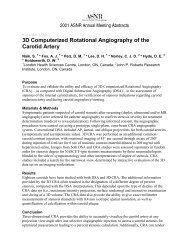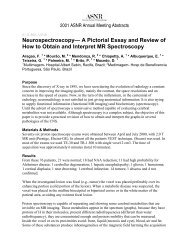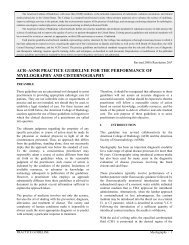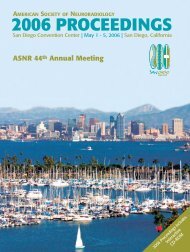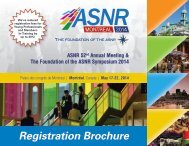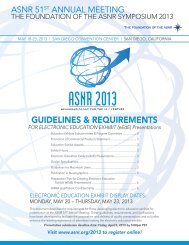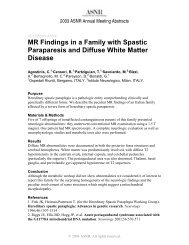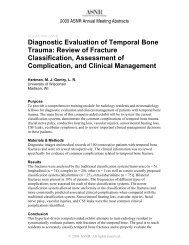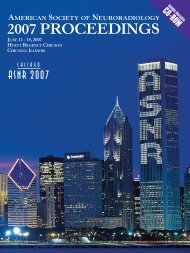acr–asnr–assr–sir–snis practice guideline for the performance of ...
acr–asnr–assr–sir–snis practice guideline for the performance of ...
acr–asnr–assr–sir–snis practice guideline for the performance of ...
- No tags were found...
Create successful ePaper yourself
Turn your PDF publications into a flip-book with our unique Google optimized e-Paper software.
4. The facility must provide adequate resources <strong>for</strong>observing patients during and after vertebralaugmentation. Physiologic monitoring devicesappropriate to <strong>the</strong> patient’s needs – includingblood pressure monitoring, pulse oximetry, andelectrocardiography – and equipment <strong>for</strong>cardiopulmonary resuscitation must be availablein <strong>the</strong> procedural suite.B. Surgical and Emergency SupportAlthough serious complications <strong>of</strong> vertebral augmentationare infrequent, <strong>the</strong>re should be prompt access to surgical,interventional, and medical management <strong>of</strong>complications.C. Patient Care1. Preprocedural carea. The clinical history and findings, including<strong>the</strong> indications <strong>for</strong> <strong>the</strong> procedure, must bereviewed and recorded in <strong>the</strong> patient’smedical record by <strong>the</strong> physician per<strong>for</strong>ming<strong>the</strong> procedure. Specific inquiry should bemade with respect to relevant medications,prior allergic reactions, and bleeding/clotting status.b. The vital signs and <strong>the</strong> results <strong>of</strong> physicaland neurological examinations must beobtained and recorded.c. The indication(s) <strong>for</strong> <strong>the</strong> procedure,including (if applicable) documentation <strong>of</strong>failed medical <strong>the</strong>rapy, must be recorded.d. The indication(s) <strong>for</strong> treatment <strong>of</strong> <strong>the</strong>fracture should have documentation <strong>of</strong>imaging correlation and confirmation.2. Procedural carea. Adherence to <strong>the</strong> Joint Commission’scurrent Universal Protocol <strong>for</strong> PreventingWrong Site, Wrong Procedure, WrongPerson Surgery is required <strong>for</strong> proceduresin non-operating room settings includingbedside procedures.The organization should have processes andsystems in place <strong>for</strong> reconciling differencesin staff responses during <strong>the</strong> “time out.”b. Vital signs should be obtained at regularintervals during <strong>the</strong> course <strong>of</strong> <strong>the</strong> procedure,and a record <strong>of</strong> <strong>the</strong>se measurements shouldbe maintained.c. Patients undergoing vertebral augmentationmust have intravenous access in place <strong>for</strong><strong>the</strong> administration <strong>of</strong> fluids and medicationsas needed.d. If <strong>the</strong> patient receives sedation, pulseoximetry must be used. Administration <strong>of</strong>VII.sedation <strong>for</strong> vertebral augmentation shouldbe in accordance with <strong>the</strong> ACR–SPRPractice Guideline <strong>for</strong> Sedation/Analgesia.A registered nurse or o<strong>the</strong>r appropriatelytrained personnel should be present and haveprimary responsibility <strong>for</strong> monitoring <strong>the</strong>patient. A record <strong>of</strong> medication doses andtimes <strong>of</strong> administration should bemaintained.3. Postprocedural carea. A procedural note should be written in <strong>the</strong>patient’s medical record summarizing <strong>the</strong>course <strong>of</strong> <strong>the</strong> procedure and what wasaccomplished, any immediatecomplications, and <strong>the</strong> patient’s status at <strong>the</strong>conclusion <strong>of</strong> <strong>the</strong> procedure (see sectionVIII.A.2 below). This note may be brief if<strong>the</strong> <strong>for</strong>mal report will be available within afew hours. This in<strong>for</strong>mation should becommunicated to <strong>the</strong> referring physician in atimely manner. A more detailed summary <strong>of</strong><strong>the</strong> procedure should be written in <strong>the</strong>medical record if <strong>the</strong> <strong>for</strong>mal typed reportwill not be on <strong>the</strong> medical record within <strong>the</strong>same day.b. All patients should be at bed rest andobserved during <strong>the</strong> initial postproceduralperiod. The length <strong>of</strong> this period will dependon <strong>the</strong> patient’s medical condition.c. During <strong>the</strong> immediate postproceduralperiod, skilled nurses or o<strong>the</strong>r appropriatelytrained personnel should monitor <strong>the</strong>patient’s vital signs, urinary output,sensorium, and motor strength. Neurologicalstatus should be assessed frequently atregular intervals. Initial ambulation <strong>of</strong> <strong>the</strong>patient must be carefully supervised.d. The operating physician or a qualifieddesignee (ano<strong>the</strong>r physician or a nurse)should evaluate <strong>the</strong> patient after <strong>the</strong> initialpostprocedural period, and <strong>the</strong>se findingsshould be summarized in a progress note on<strong>the</strong> patient’s medical record. The physicianor designee must be available <strong>for</strong> continuingcare during hospitalization and afterdischarge.EQUIPMENT QUALITY CONTROLEach facility should have documented policies andprocedures <strong>for</strong> monitoring and evaluating <strong>the</strong> effectivemanagement, safety, and proper per<strong>for</strong>mance <strong>of</strong> imagingand interventional equipment. The quality controlprogram should be designed to maximize <strong>the</strong> quality <strong>of</strong><strong>the</strong> diagnostic in<strong>for</strong>mation. This may be accomplished aspart <strong>of</strong> a routine preventive maintenance program.6 / Vertebral Augmentation PRACTICE GUIDELINE



